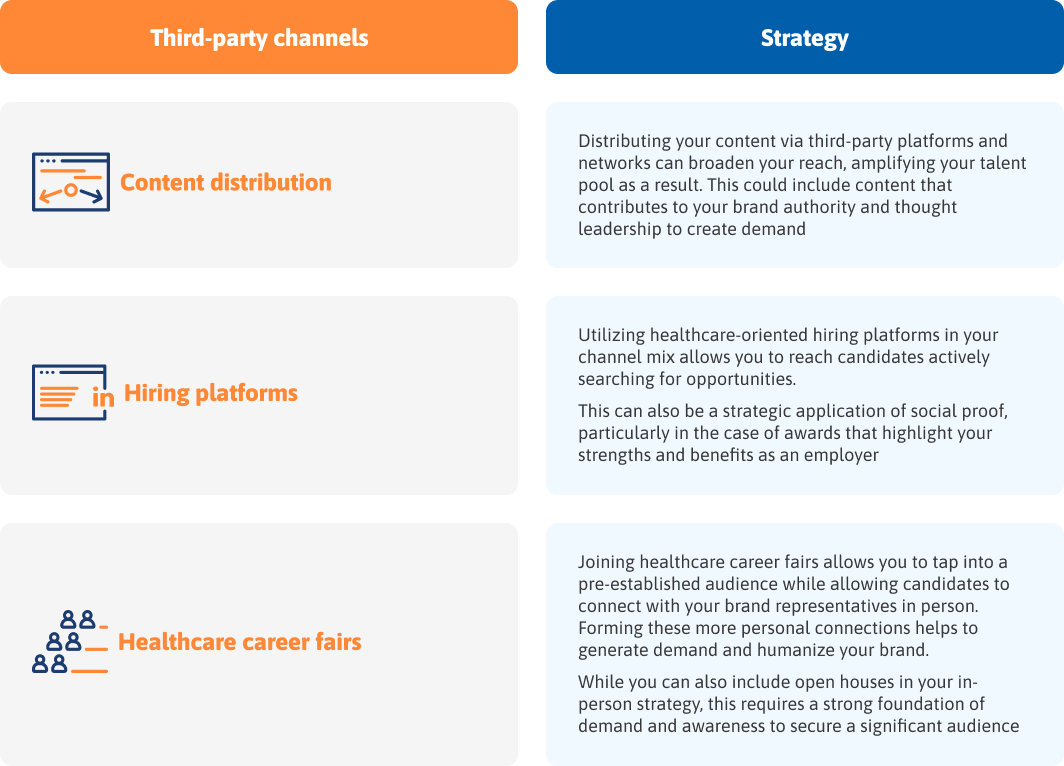The U.S. healthcare sector continues to be impacted by an acute shortage of trained professionals across all functions and levels (particularly home health aides and support personnel).
Results for “”


The causes of the current healthcare workforce shortage
How demand generation can be leveraged to support recruitment and retention
The U.S. healthcare sector continues to be impacted by an acute shortage of trained professionals across all functions and levels (particularly home health aides and support personnel).
Indeed, a 2024 report by the National Center for Health Workforce Analysis predicts a shortfall of more than 180,000 physicians, over 200,000 registered nurses, and 300,000 licensed practical nurses by 2037 (NCHWA, 2024).
Additionally, this issue is compounded by America’s aging population, as there will be over 75 million Americans over the age of 65 by 2035 (Census Bureau, 2023).
As this issue continues to escalate with time, pressure is on healthcare providers to implement strategies to counteract the shortage and bolster their services with a steady pipeline of professionals.
This article examines the underlying causes of this workforce shortage, along with demand generation solutions that healthcare providers can implement to tackle this challenge.
The workforce shortage plaguing the U.S. healthcare industry is a multi-dimensional problem. The increasing pressure on healthcare teams, especially nurses and nursing assistants, is accentuated by low compensation, high job demands, and stringent education requirements.
Below is a brief overview of the factors contributing to the healthcare workforce shortage:
These three issues underscore the need for effective strategies to attract, train, and retain healthcare professionals.
At its core, demand generation strategies develop and leverage long-term interest to support growth goals and establish brand awareness.
While this typically involves engaging and nurturing prospective clients, the fundamentals of demand generation can be applied to healthcare recruitment and retention efforts to support talent recruitment and retention.
Below are the top three ways that demand generation strategies can be leveraged to tackle the healthcare workforce shortage:
Brand awareness plays an important role in cementing your organization’s identity in the healthcare industry for potential candidates.
Showcasing your values, culture, and most importantly, the opportunities your brand represents, is a powerful way of garnering and maintaining interest from candidates as they become aware of your brand.
You can also gain awareness for your brand by applying demand generation strategies to boost your brand’s authority within the healthcare industry and your specific niche(s). Support this initiative by considering producing a variety of content marketing assets. These can include industry research and reports, thought leadership articles from your leaders, and social proof that demonstrates the quality of service your organization provides.
The more you invest in your brand identity and awareness, the more likely your organization will attract and secure talent inspired by your mission and goals. Taking a proactive approach helps to build a demand generation foundation that creates a pipeline of skilled individuals aligned with the needs and vision of your organization.
ESTABLISH YOUR BRAND AWARENESS WITH DEMAND GENERATION PROGRAMS CRAFTED TO YOUR UNIQUE NEEDS WITH INFUSE HEALTH
Demand generation programs can also be leveraged to drive engagement with your brand.
Before implementing this strategy, be sure to consider your marketing channel mix. Much like your prospects, candidates will have different preferences regarding communication platforms and channels.
Expand your reach by appealing to a broader range of preferences by building an omnichannel presence, including the following strategies (divided into owned and third-party channels):


Activating an omnichannel strategy can help to amplify your brand, increasing your reach, and positioning your organization as a desirable workplace.
Maintaining engagement across a broad range of channels can be challenging. However, omnichannel strategies are a powerful tool for contributing to brand awareness and demand, priming potential candidates to contemplate applying to your organization when they consider their career progression.
Omnichannel marketing can also result in more referrals, as a result of its diversity and reach. This is especially true in the case of social media) as healthcare professionals share your content and advertisements with colleagues and peers.
While combating churn at your organization is likely an HR initiative, demand generation can be leveraged to strengthen existing strategies—across your internal channel mix.
These can include:
The onboarding process: Collaboration between HR and demand generation teams can help to strengthen the onboarding process by cementing brand value. Indeed, investing in demand generation at the beginning of the hiring process can result in better onboarding as candidates who have been nurtured are more likely to become brand advocates
Leveraging regular feedback: Fielding feedback from healthcare teams is an important process and ensures that important issues are heard and addressed. Demonstrating that the voice of your teams is valued is particularly important. Demand generation can amplify the reach of materials that showcase feedback and how solutions were implemented. Featuring the voices of your team members can also contribute to a smoother onboarding process
Success stories: Similar to feedback, utilize demand strategies to promote success stories both internally and externally to counteract churn and support your recruitment pipeline
Educational webinars and workshops: Holding regular learning opportunities not only demonstrates your commitment to investing in your team members, but also contributes to the value of your organization for career development. Consider developing these in partnership with recognized educational institutions to leverage their existing programs, resources, and expertise. Support this by deploying demand strategies for promotion of these events, as well as creating content based on the topics explored
In essence, demand generation strategies can be implemented to activate your HR efforts to reduce churn by increasing reach and engagement.
The healthcare sector faces considerable challenges if workforce shortages are not addressed proactively
Demand generation plays an important role in establishing a strong foundation of interest in potential candidates, leading to improved brand awareness, authority and equity
Demand generation strategies can be applied to recruitment and retention initiatives to build a steady pipeline of candidates by amplifying reach and boosting results
ENRICH YOUR RECRUITMENT AND RETENTION STRATEGIES WITH INFUSE HEALTH
INFUSE Health experts understand the challenges of the healthcare workforce crisis, and the long-term implications if they are not adequately addressed.
Our INFUSE Health team works with you to craft and deliver demand generation programs tailored to your unique needs to support a robust pipeline of potential candidates for your organization.
To provide the best experiences, we use technologies like cookies to store and/or access device information. Consenting to these technologies will allow us to process data such as browsing behavior or unique IDs on this site. Not consenting or withdrawing consent, may adversely affect certain features and functions.